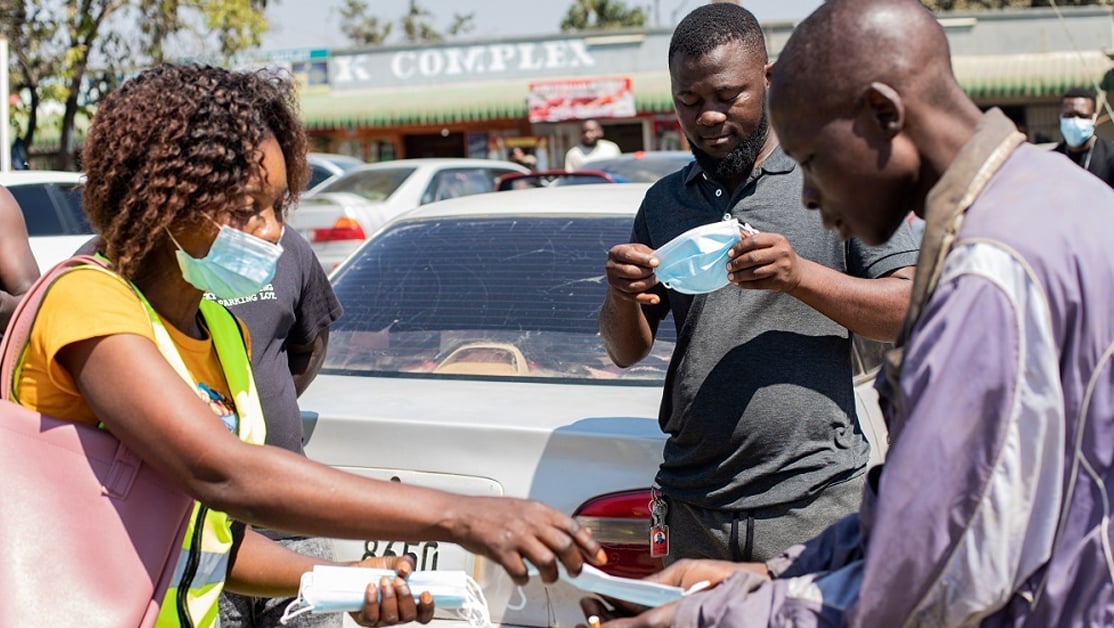At a glance
This story demonstrates the unique challenges CDC and its partners faced when addressing the TB and HIV epidemics during COVID-19. Although the pandemic decreased some progress, TB programs remained resilient.

Background
On September 26, 2018, over 1,000 heads of state, political leaders, civil society representatives, and other stakeholders gathered at the United Nations (UN) General Assembly. This gathering signified the first UN High-Level Meeting (UNHLM) on tuberculosis (TB). Only four other health conditions have been the focus of meetings at this level in the history of the UN.
TB was declared a global emergency more than 25 years ago. Despite being preventable and treatable, this disease still claimed the lives of an estimated 1.4 million people in 2019.
By the end of the meeting, 120 countries committed to work together to reach 10 ambitious targets as part of a Political Declaration to end TB by 2030.
Global commitments to TB treatment
At the CDC-sponsored UNHLM side-event, Preventing TB to End TB, prominent figures attended, including:
- Government leaders from India, South Africa, and the United States.
- Representatives from the world's leading multilateral institutions.
- Prominent clinicians and advocates.
These attendees extended their commitment to reaching 30 million people with TB preventive treatment (TPT). TPT is a lifesaving medication that can dramatically reduce TB disease and TB-associated death, particularly among people living with HIV (PLHIV). TB and HIV are interconnected as TB is the leading cause of death for PLHIV.
At the event, Ambassador Deborah Birx, M.D., the U.S. Global AIDS Coordinator, committed to providing TPT to all PLHIV by 2021. This plan was supported by the President's Emergency Plan for AIDS Relief (PEPFAR). Since then, national TB and HIV programs have intensified their efforts to scale up prevention measures. The ultimate goal of the programs is to end TB and achieve the ambitious UNHLM targets.
The impact of COVID-19
The second anniversary of this historic meeting came amid much more sobering times. At the beginning of 2020, the number of TB cases had fallen by 9 percent. Furthermore, the number of TB deaths decreased by 14 percent since 2015. These achievements showed slow but steady progress towards the UNHLM targets. Additionally, TPT initiations, implemented through PEPFAR, had nearly doubled between 2019 and 2020.
Then in early March, COVID-19 was declared a global pandemic. Country lockdowns and treatment interruptions caused concern among those on the frontlines of the global TB response, especially regarding progress. The global TB community was now faced with achieving UNHLM targets and ending TB in the midst of a pandemic.
In the first four months after COVID-19 was declared, TB notifications decreased. For example, in most sub-Saharan African countries, notifications dropped by 25 to 30 percent. A modeling study indicated that the pandemic could reverse global progress toward ending TB to levels seen five years ago. This would result in an increase of approximately 6 million TB cases and 1 million more TB deaths by 2025.
CDC's resilience
CDC, in partnership with national governments, have been working on the frontlines in more than 25 high burden countries. During the COVID-19 pandemic, this effort aimed to strengthen the critical public health infrastructure to address COVID-19 while working to achieve global TB and UNHLM targets.
In several countries, CDC and partners integrated TPT into HIV treatment differentiated service delivery models.
This approach to care:
- Tailors treatment to the patient’s needs.
- Reduces the time spent in the health clinic.
- Increases correct prescription adherence.
Kenya
In Kenya, CDC-supported sites used a model that allowed patients to receive their full, multi-month medications at one clinic visit. This decreased the need for multiple visits that could increase risk of exposure to COVID-19. Phones and platforms like Zoom helped support patients with checking for treatment adherence and negative side effects. As of June 2020, 90 percent of all people living with HIV in Kenya had been initiated on TPT.
Uganda
Similarly, in 2019, the Ministry of Health in Uganda implemented a 100-day accelerated TPT scale-up plan. This plan aimed to reach 304,000 people living with HIV with TPT. As part of the initiative, Uganda refilled patients’ TPT and HIV medication simultaneously. This led to increased patient education and closer monitoring of TPT patients at every clinic visit.
Nigeria
Nigeria adopted a similar approach of increasing demand and uptake for TPT. The country achieved this by widening TPT eligibility criteria with a new screening tool and integrating TPT into HIV programs.
Between October 2019 and June 2020, Nigeria initiated over 200,000 people on TPT. There was only a slight decrease in monthly initiation during COVID-19 lockdowns.
Reaching UNHLM targets
In 2022, the halfway point for reaching UNHLM goals, the World Health Organization (WHO) released an overview of global progress towards achieving the UNHLM targets. The report showed that, while there had been progress, there were significant challenges meeting the UNHLM goals.
In many ways, COVID-19 shined a spotlight on the resiliency of TB programs around the globe. It highlighted the importance of strong public health infrastructures to effectively address new and emergent health threats. CDC, along with partners and national governments, used innovation and leveraged the public health platforms they built to navigate COVID-19. Moving forward, the goal is to maintain essential TB services and drive progress towards global targets to finally end this epidemic.
